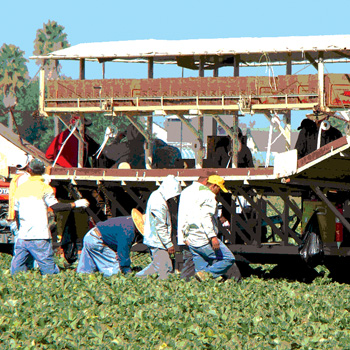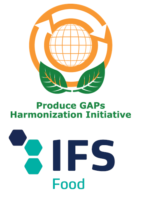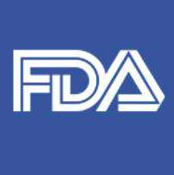Each year in this country, foodborne illnesses cause sickness, death, and accompanying economic costs that can cripple companies and erode public trust in the safety of the food supply. Despite the best efforts of both government and industry, fresh produce continues to be both the subject of frequent recalls and linked to foodborne illness.
As you know, food safety remains an important priority for the current administration. Shortly after taking office, President Obama established a Food Safety Working Group (FSWG), which brought together experts from all federal agencies with responsibilities related to food safety, to improve the nation’s food safety system by prioritizing prevention, strengthening surveillance and enforcement, and improving response and recovery following foodborne illness outbreaks.
In August 2009, U.S. Food and Drug Administration (FDA) Commissioner Margaret Hamburg created the Office of Foods to lead a functionally unified FDA Foods Program and enhance the Agency’s ability to meet today’s challenges and opportunities in food and feed safety, nutrition, and other critical areas. Part of the mission of the Foods Program is to protect and promote public health by setting science-based standards for preventing foodborne illness and ensuring compliance with those standards.
We at FDA think of this as a unique time, and it is the right time for changes in food safety. Why? The public, Congress, industry, and consumer groups are all demanding and expecting change. Each of those groups has a responsibility in the farm-to-table model, and everyone agrees that each must do their part to improve and modernize the system and improve public confidence in our food supply—by making prevention the central focus.
Changes in Produce Standards
Late last year, FDA announced that we would soon begin work on a proposed rule that would contain standards for the production, harvesting, and packing of fresh produce. Usually, when a government agency makes such an announcement, a proposed rule is written and is then put out for comment. This time, we decided that it was essential to reach out to growers big and small across the country before writing any rule. Therefore, in February 2010, we opened a docket to receive comments. We did this because we wanted to fully understand the current, diverse food safety practices and challenges encountered by the people who grow food across the country.
Additionally, to see first-hand what farmers were talking about, we decided to go on the road. In the last several months, FDA has traveled around the country, participating in listening sessions and touring farms, engaging in active dialogue with the people who will be directly affected by our rule-making action.
We began with a joint FDA/U.S. Department of Agriculture (USDA) visit to several farms in the Eastern Shore produce production area of Delaware, Maryland, and Virginia (known as the Delmarva). Growers were skeptical at first—what’s FDA doing on the farm? What do they really want from us? However, with the help of some dedicated state departments of agriculture, extension service professionals, industry representatives, and other groups, we began a journey that would eventually educate and enrich us in ways we didn’t expect. Since that first trip to the Delmarva to convince growers that we really did want to hear what they had to say, we’ve visited 13 states around the country.
To gather more input, we participated in a five-part discussion series sponsored by the Produce Safety Project (PSP) at the Pew Charitable Trusts. The PSP proposed that it would work with various state and local officials and other groups that focused on key on-farm produce safety issues. Hundreds of growers attended each of these sessions. Senior FDA and USDA officials were available at the smaller breakout sessions to hear what growers and packers were saying to each other, and to answer questions or clarify the roles of FDA and USDA. The discussion series was organized around four major topics: 1) worker health and hygiene; 2) composting; 3) irrigation and foliar contact water quality; and 4) environmental and food safety on-farm co-management.
States also invited us to participate in listening sessions. Some states took our outreach concept to a higher level of involvement. The North Carolina Task Force on Produce Safety not only invited us to the state for a listening session and tours of farms, but went on to organize 17 more sessions on its own around the state. The Task Force has since submitted to the open docket many pages of insightful comments from the more than 300 growers who attended those state-level sessions and made their views known.
Then, there is the Amish farmer we first made contact with at a state produce growers meeting in Sandusky, Ohio, back in January. When an FDA representative indicated that comments for the upcoming docket could be submitted via www.regulations.gov, the farmer politely let her know that he did not have a phone or use a computer, but if we got information to him by mail, he would get thousands of small farmers in his state to become part of the comment process. We wrote to him and included the information.
Moving Forward
Since that first meeting, we have maintained our relationship with the Amish farmer, and he has brought other members of the Amish community into the dialogue. Just a few months ago, we visited his farm and others operated by the Amish in Ohio and learned first-hand about some of the basic food safety measures used by that community. We are now applying what we’ve learned to find ways that can preserve their way of life for the next generation without sacrificing food safety.
Trends quickly developed in what we were hearing in the listening sessions—each new breakout group provided even more depth and dimension to issues that we continued to see throughout our visits. There was consensus on many issues—wide disagreement on others. At the PSP listening session in Columbus, Ohio, a participant said, “It takes just one pathogen to make someone sick—and that pathogen can come from any farm.” In Portland, at a listening session held jointly by the states of Washington and Oregon, a small grower stood up and said that FDA should have no role in regulating growers—that it was an intrusion and “un-American.” At that same session, another grower insisted that food safety was everyone’s concern and that we needed to figure this out together.
A sampling of the comments we heard includes the following:
• Hold imports to the same standards.
• The standards must be practical, common sense.
• Don’t put new regulations on top of existing ones.
• Take into account the diversity of commodities, distribution channels, and practices.
• Don’t duplicate efforts.
• Make sure the standards are risk-based.
• Don’t burden us with too much recordkeeping.
• Give us a strong education and training component, preferably at no cost.
One thing that became clear early on was that one size does not fit all in produce safety.
Another consistent theme we heard is that growers are eager for information on best practices and on how we see compliance in terms of the proposed regulation. That’s why we are also working to develop a robust education and outreach component that will provide relevant information to all parties. We will need to partner with existing resources so that scarce funding is not used on duplicative efforts. We are exploring alliances with universities, associations, and other organizations to help provide training in preventive controls and to develop comprehensive, robust food safety plans based on a scientific approach that can also be tailored to a particular operation.
We have also held conference calls and smaller meetings with groups such as the National Organic Coalition. In that call, we didn’t just say we were working closely with USDA’s National Organic Program (NOP)—we had the director of the NOP with us on the call to answer questions. FDA-USDA relationships have never been stronger. In resource-constrained government institutions at all levels, we need to create mechanisms to make it possible for us to work together with our state partners through the National Association of State Departments of Agriculture, extension agents, the Natural Resources Conservation Service, key produce industry groups, state health departments, and others—partners we will rely on heavily in the months and years to come.
As mentioned earlier, in several areas where listening sessions were held, we had the opportunity to tour farms and talk to the owner/operators—including organic, sustainable farms, and farms ranging from small 10-acre farms up to ones that farm thousands of acres. We learned about whether farmers were following and implementing Good Agricultural Practices; what practices worked for them when it comes to educating workers about proper handling of produce; how they make sure water is safe to irrigate crops; and so much more—and we encouraged them to submit their comments through the open docket.
More than 500 comments had come in by mid-July—and the interesting thing is this: while the comments began with skepticism, just like in the Delmarva, the tone has definitely changed (see the sidebar on p. 23 for sample comments submitted through the docket). We’re getting solid information on practices that work for growers—and on those practices that don’t work. And, most importantly, we’re getting suggestions for how to improve things.
Goals for the Future
FDA’s goal is to develop preventive controls and specific actions that can be followed all the way down to the farm level and throughout the supply chain—and to develop these standards in a thoughtful and practical manner simultaneously. Just as important, we need to find a way to provide growers and packers with the education and training necessary to ensure compliance with these preventive controls.
Produce safety is one of the most complicated areas that FDA has tackled, and one of the most interesting. In order to determine the best way to prevent risk, we must consider the diversity of commodities, how practices vary depending on the size of operation, geographic differences in growing conditions, varying distribution and marketing channels, etc. We are all still learning.
This is the time when we need to make some fundamental shifts in the way we do things in produce safety. Fortunately, we have support to do so from multiple fronts. One thing we can all agree on is this: we are all accountable in the food safety arena. We all have a role. We all have a responsibility.
FDA will use the thoughtful comments and information that hundreds of people around the country have provided to us to write the best rule possible: a rule that is inclusive but not burdensome; one that uses the best available science but also makes allowances for practicality; and standards that allow the people who grow the food to respect their way of life and a deep connection to the land while keeping the food supply both plentiful and safe.
Read the sidebar: Sample Comments Submitted to the Preventive Controls for Fresh Produce Docket
James Gorny, Ph.D., is the senior advisor in the Office of Food Safety, FDA’s Center for Food Safety and Applied Nutrition (CFSAN). Actively involved in the produce industry since 1986, Dr. Gorny has worked extensively, both nationally and internationally, on perishable quality and food safety issues. He is on the editorial advisory board of Food Safety Magazine.
Leanne Skelton is currently on assignment from USDA, working on produce safety rule development and efforts aimed at supporting the upcoming rule, including developing strategies to engage other partners, and approaches to related compliance, inspection, and enforcement policies. She has nearly 25 years of experience with USDA fresh fruit and vegetable programs, and is Chief of the Agricultural Marketing Service’s Fresh Products Branch.
Sue Challis is with CFSAN’s Communications and Education Division, recently detailed to the Produce Safety Staff to help develop strategies for communication and outreach in support of the upcoming produce safety rule. She has more than 25 years experience in communications, retail food operations, health care, and agriculture-related issues.
Sidebar
Sample Comments Submitted to the Preventive Controls for Fresh Produce Docket
“It is important that the FDA consider the size of a farm when making regulations. Small farms are not high-risk operations for food safety. While all farmers need to understand and use good food safety practices, small farms should not be subject to unreasonable certification requirements (known as [Good Agricultural Practices] GAPs) that could put them out of business because of the cost and time commitment….We need to protect and nurture those small farms that we can personally visit to see how they are handling their produce. Their connections with their customers are personal and they care about the quality of what they produce.”
-Sustainable Westford
“There is some evidence that in Wisconsin great strides have been made in developing GAPs guidance and teaching produce operators to perform self assessments and develop food safety plans. In a recent small survey…90% of growers reported that they cooled produce immediately after harvest, kept it refrigerated, had a trace-back system, and used composted manures.…there is still a high level of confusion...our recent survey also showed that small, diversified growers are in need of technical assistance and would like an easily understood self-audit program…”
-Wisconsin Department of Agriculture
“A food safety plan and environmental assessment will help to identify areas of concern for small and large operations, although the complexity of the plan and assessment are likely to be less for the smaller operation. On-site evaluations and reviews of current literature are two possible approaches to tailoring preventive controls to the scale of an operation. Wegmans believes it would be appropriate for the FDA to provide a guide to potential hazards in fresh produce operations....Further, we believe that the FDA and other established entities such as the extension service of the land grant university system can play a very significant role in the education of growers on how to comply with regulatory requirements.”
-Wegmans Food Markets
“A sensible solution could be the institution of a program run much like our Commercial Pesticide Applicator license. Require a certain level of education for one grower from each farm. Require that person to pass a test on food safety and in turn educate all their farm workers. That would secure the certification. After that, have continuing education to earn credits to keep the certification valid. Participation would be much greater and involve more small farms, therefore influencing more food production. If there is a need for more regulation, it could always be enacted when more scientific answers are known. Please tell Congress that the FDA is interested in fair and sensible programs that are based on scientific fact and not programs based on assumptions.”
-Miller Plant Farm Inc.



